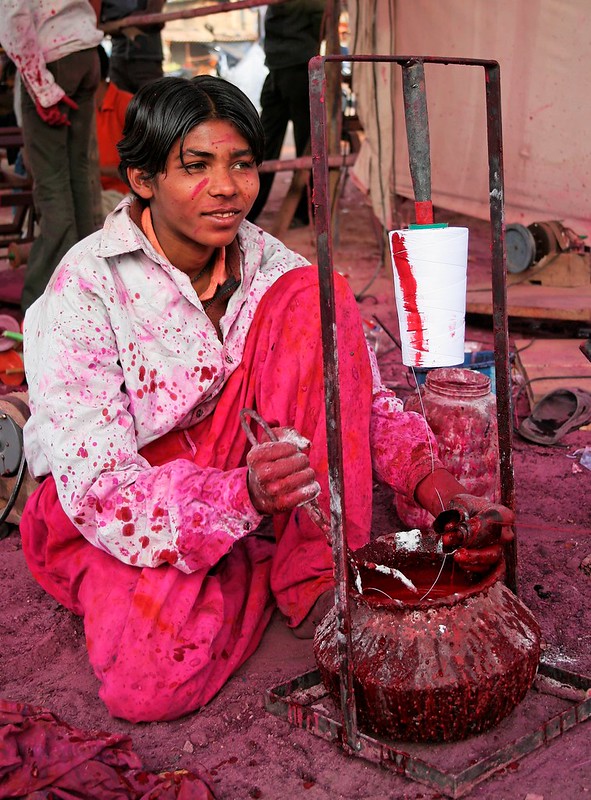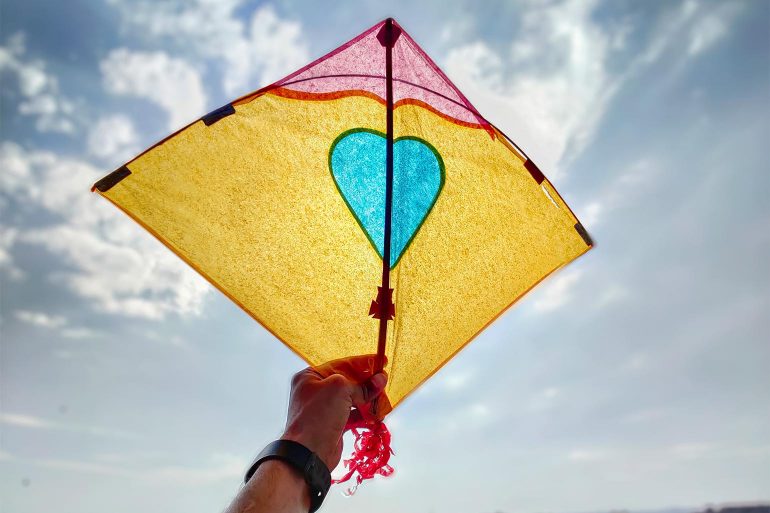“Kites give these young children a reason to look up the sky, to play in it. Is that ordinary? No, it will give them dreams,” a 70-something Mansood Khan states as a matter of fact. Khan, previously a kite maker, keeps us company while we wait for Ahmed Kazi to pick us up and take us to his workshop in a world unaware of coronavirus and lockdowns. Kite designer/maker Kazi owns a small-scale business of paper kites including a shop in a by-lane of one of the busiest roads in Mumbai where his wife retails the best of the lot.
I step over many tattered kites as Kazi guides us through the convoluted and congested lanes that lead to his house, a room and kitchen in the suburbs. On the way, I ask Kazi if the kite business is still lucrative enough to get into. “It is not very profitable as the margins are quite low. The population is exploding but the public interest in kites is declining. But I won’t say that it’s bad. And personally for me, this business is our legacy,” he says.
Kazi relinquished a promising career in politics after his father’s demise and has been in this business for four decades now. It is a legacy, bequeathed to him by his grandfather and father. Though he is the last one from his family to carry the baton. “I have one daughter and she has chosen a different career for herself,” he says with a contented smile.

The paper for the kites is sourced locally. “Bombay has many options when it comes to paper, but the bamboo for the thadda comes from Bengal or Assam.” Thadda is a colloquial term for the spine and spar of the kite. It is made of bamboo, the best quality of which comes from the East, the bamboo producing areas of the country. “If the thadda is not strong, the wind will snap the spine. And if the thickness of the sticks is not even, the kite will keep dipping in the sky,” says Kazi.
In the well-lit corridor outside his house, five workers carry out different operations with machine like speed and accuracy. Similar to a production line in any factory, each labour is assigned a task he/she specialises in.

The deciding step in the process is cutting the paper, and it is undertaken by a cutting master. A cutting master or ustad prepares carefully calibrated stencils. These are then used to cut out the shape of the kite from the paper lot to make the sail or skin of the kite. He handles the entire cutting process himself as he has to account for marking of notches for the keel or tail, and adding margins near the wingtips to secure the ends of the spar.
Symmetry, the cutting master tells us, is the single deciding factor irrespective of the shape of the kite. “A good kite will balance perfectly on its bridling point. And since we cannot tie bridle to kites to check the quality, it is necessary to pay attention while making it,” he explains. For sticking, an adhesive of food starch like boiled rice or an over-boiled squishy refined wheat called laivey is used. Laivey is “cooked” by a designated operator.
Most of these jobs are taken up by families living in the slums of Dharavi. I again trail behind Kazi to see these small pockets of kite making families, passing by many old men like Khan who were enthusiastically winding abandoned kite strings to make their own manjha (kite string coated with a mixture of laivey or rice, finely grounded glass and a bright colour). We started from the congested residential area close Bandra station immersed in conversation; after walking through factories, grounds and trespassing several properties, we were in Dharavi, for me, another miracle of the city.
In Dharavi, I was greeted by a family of three in a 10X6 feet house boisterously arguing with each other. They are also making kites. The children, a son and a daughter, both in their teens, also make kites, but rarely fly them. “But sometimes we have kite fights,” the son says. “I am really good,” he adds.
The majority of kite producers in the country, including Kazi, primarily produce flat kites (basic diamond shaped kites). “They are the easiest and most production efficient. We have made kites as big as six feet and in various shapes, but those are not for business,” he says. Besides most of the Indian kite flying festivals are about friendly kite battles for which the traditional diamond kites (also known as fighter kites) are best suited.

“During the season time, we make almost five to seven thousand kites in a day,” said Kazi. He admits, a bit hesitantly, that his business is small because his brothers opted for other professions and in the absence of any support, there were no prospects of expanding the business. Season time, he specifies, is from August to January—Independence Day to Republic Day. This year there was no production, and with the lack of storage space, the old lot is unusable. The season time is feared to be the worst for India’s cover-19 cases.
Around the year Kazi would usually get orders from corporates, but this year has been a tough one for them as well. In the pre-covid days, he complained about business from corporates not being profitable “The margins are the same but there is an added tension of matching their brand colours, placing their logos and getting their approvals. It is alright for off-season but we procure raw-materials from local markets and we can’t really control such minute details or maintain a strict uniformity,” he said. We stood over torn pieces of blue kites with a bank logo painted on them. He gestured me to move my foot. “Look they said there was difference in the blue,” he pointed at the kite previously under my foot. There was a clear difference. “Right shade of blue is so difficult to get. Now I tell the companies we don’t do blue,” he said.
I asked him if his business, like many others, is hit by Chinese products. Kazi doesn’t feel so. Our neighbours who are rightfully the originators of the kite have not been able to grip the kite market in the country. Though Chinese kite strings made of nylon and plastic were gaining popularity, the government’s ban on them have stubbed that. And the Bombay market again flourished with manjha from Bareilly.

Though it would be easier to order kite strings from Gujarat, Kazi says, the customers prefer these from the further north, like Uttar Pradesh, the kite string from Gujarati is lavishly coated with grounded glass.
The only little intrusion in the kite market is perhaps the Chinese lanterns that people light in the night. “Though the lanterns are eating a portion of the kite budget, they look very pretty in the night sky,” said our old man Mansood Khan.
**


